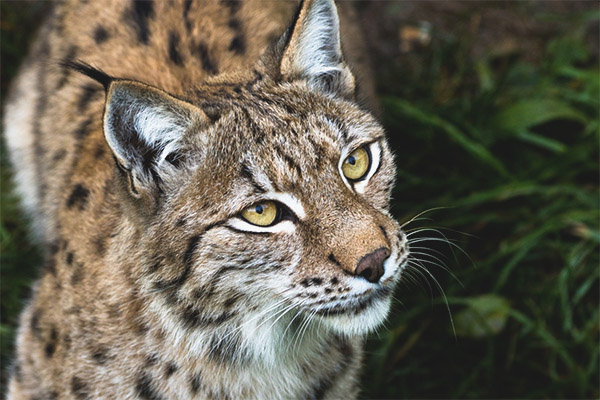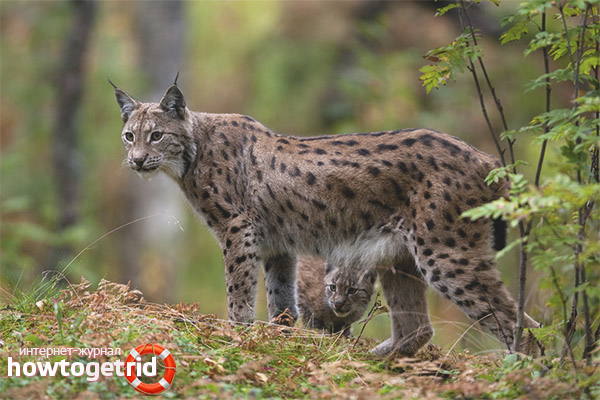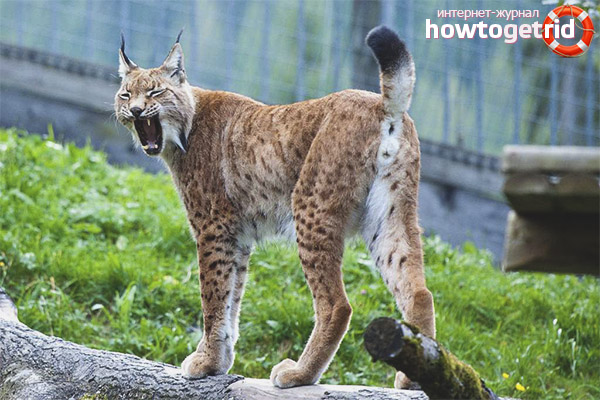The content of the article
The lynx ordinary (Eurasian) belongs to the feline family (Latin Lynx lynx) and is the closest relative of the domestic cat.
Appearance
The lynx is small in comparison with other members of the family, but is the largest among other species of lynx. The weight of a large male can reach 36 kg, individuals of medium size have a mass of 20-25 kg. The length (excluding the tail) ranges from 70 to 130 cm. The height of most animals is no more than 70 cm. Males are stronger and larger than females.
The body of animals is short, dense. The head has a rounded shape, the muzzle is shortened with large eyes wide apart. The tail is short with a black tip, it seems slightly chopped off, its length rarely exceeds 35 centimeters.Such size and shape of the tail helps the animal to cleverly climb trees, using it as a balance weight.
Lynx hair is very soft and thick, especially after autumn molting. Wool growing in the spring, shorter and less dense, the pattern of the pile is much clearer, more contrast.
The color of the animals may be red, yellow or gray. Depending on the habitat, patterns on animal hair can be striped and spotty (spots and rosettes of various sizes). There are representatives with a solid color. On the neck, abdomen, ears and paws, the patterned color is less pronounced. On the cheeks, as well as on the belly, the pile is longer and thin, resembling sideburns. At the tips of the ears, lynxes have special tassels that allow them to pick up sound waves that are not accessible to other mammals. Thus, these brushes are like a direction finder. If they are cut off, the hearing is immediately noticeably dulled.
The anatomical structure of the paws is somewhat different from the structure of other members of the family. The forelimbs are noticeably longer than the hind ones and there are 5 fingers on the trot, and 4 on the hind limbs. But the footprint of the forepaws, like the hind paws, will still have an impression of only four fingers, since the fifth finger is above the others and does not touch the snow or the ground when walking.
By winter, the paw pads are overgrown with thick, stiff fur, which makes the lynx quickly and easily overcome the snow drifts and move, without hurting the sole, over the ice crust.
Behavior, lifestyle
The trajectory of the trot is winding. If the snow drifts are not deep, the beast puts its paws so that prints from the back are in front of the front ones. If the depth of the snow is significant, it moves, placing the hind limbs in traces from the front. If masking is necessary, the lynx, naturally, makes a route through stumps and trees.
Cats hunt alone. Females with brood extract food together. These predators prefer a sedentary lifestyle and leave their territories only in case of depletion of food resources. The area of possession of a single predator is sometimes 70 square kilometers. Animals periodically make their rounds, which often takes up to two weeks. During the day the lynx can go 8 km in search of prey.
Species of lynx vulgaris
Depending on the habitat, several subspecies of predators are identified:
- East Siberian (Yakut) lynx. At the beginning of the twentieth century, this subspecies independently settled in the southern territories of the Kamchatka Peninsula. Yakut lynx is the largest of the ordinary. Their fur is fluffy and soft with a pronounced spotting. With an abundance of food supply, animals lead a sedentary life in Yakutia. In the case of a decrease in the number of game, the animals migrate to richer food areas. 80% of the diet of lynx are hare, the rest is for feathered and large horned animals.
- Central Asian (Pale) Lynx. Representatives of this subspecies live in the highlands of Kazakhstan and the central part of Asia. The color of these animals is predominantly monochromatic and light. The spots are mild on the limbs and back.
- Caucasian lynx. Predators are medium in size compared to other representatives of the species. They have a characteristic chestnut or auburn chestnut color with a bright spot.
Places of residence of ordinary lynx
Until the end of the XIX century, these animals inhabited the forests of Central and Western Europe. Due to the popularity of lynx fur and the destruction of forests by the beginning of the 20th century, they were exterminated in Germany, Switzerland and France. Since the 70s of the last century, thanks to the activities of defenders of wildlife, this type of cats has been re-populated in some countries.
Today, the lynx ordinary is listed in the Red Book. Populations of predators, numbering from 1000 to 2500 individuals, inhabit the forests of Sweden, Poland, Norway and Finland.
In the states of the Balkan Peninsula (Macedonia, Greece, Albania), the number of Eurasian lynxes has declined over the past 20 years. What is directly related to human activity. Their number in these countries is less than 100 individuals.
Most habitats of the common lynx are in Russia, mainly in the regions of Siberia. There are animals on the western borders of the country to Kamchatka, Sakhalin, as well as in the Caucasus.
Lynxes prefer mixed and coniferous forests on rocky mountain landscapes. They settle in the forest tundra and in those localities where low-growing shrubs grow.To raise offspring go deep into the forest, where vegetation is thicker and denser.
The enemies of the lynx, in addition to humans, are wolves. Lynx can cope with one wolf, but the pack will not overcome. Therefore, in the territory where wolves live, lynx prefer not to linger. If the number of wolves is reduced due to the extermination of them by man, then their number in the same area increases. In some areas of Russia, individuals were shot, as it was believed that the predator destroys a lot of game of value (for example, roe deer, black grouse, hares). But given that the rate of reproduction, and, consequently, the increase in the number of animals fed by lynx is much higher than that of predators, the harm from hunting is in great doubt.
Common lynx diet
Lynx, like all cats, eat animal food. The daily prey of these predators is lemmings, voles, hares and some birds. Sometimes young individuals of elks and wild boars become victims. Lynxes also hunt larger animals: deer, roe deer, musk deer, seren. If lynx hunting grounds are located near human settlements, then often livestock and poultry become its prey.
Lynxes begin hunting at the end of the night or in the early morning, when the terrain is not yet sufficiently illuminated by the sun. The predator carefully and patiently tracks down the victim, and then attacks, making 2-3 sharp jumps up to 3 meters long. If the prey escapes, then it follows about another 80 meters, in case of failure, it retreats. The lynx does not jump to the victim from a branch or trunk of a tree, but looks out for it from a height. The average daily ration of meat is about 3 kg, in which case the lynx will not feel hunger. After a long hunger strike, the beast can eat six kilograms of meat.
The lynx never hunts for good, that is full. The animal buries the remains of carcass into the snow or sprinkles it with earth, but it is not so neat that other predatory animals easily find a “cache”. Lynx tracks are often tied up with foxes and wolverines. The latter can sometimes discourage caught prey and drive away the lynx. With foxes, the situation is different: foxes compete in the food chain, in addition, they are much weaker. A fox seen on the territory of a lynx hunting territory will most likely be killed by the “mistress”. At the same time these predators never eat foxes.
On its hunting routes, the lynx leaves traces in the form of scratched tree bark, as a kind of signal that the territory is occupied.
Reproduction and raising brood
Wedding time at the lynx begins in February and lasts until the end of March. 2-3 males follow the female, sometimes more, who constantly fight for its location. Battles are accompanied by menacing growls and meowing of low pitch, spreading for many kilometers around. Having formed a pair, the animals sniff each other's noses, then begin to slightly butt their foreheads, standing opposite.
Females raise their young.At the age of two months, the mother begins gradually feeding the kittens with meat. Until the age of five months, babies still do not leave the lair and learn to hunt the mice and hares brought by the female. For half a year the lynxes are already learning to hunt for real.
"Parental home" young leave when they are 1 year old. The female mother drives them off to an independent life and acquires a new offspring. Males of lynx reach sexual maturity at the age of two and a half years. Females - 1.5 years.
The life span of a lynx in the wild is on average 20 years. In zoos, some individuals can live up to 25 years.
Video: Common Lynx (Lynx lynx)













To send